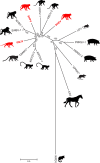Historical Outbreaks of Simian Hemorrhagic Fever in Captive Macaques Were Caused by Distinct Arteriviruses
- PMID: 25972539
- PMCID: PMC4505640
- DOI: 10.1128/JVI.01046-15
Historical Outbreaks of Simian Hemorrhagic Fever in Captive Macaques Were Caused by Distinct Arteriviruses
Abstract
Simian hemorrhagic fever (SHF) is lethal for macaques. Based on clinical presentation and serological diagnosis, all reported SHF outbreaks were thought to be caused by different strains of the same virus, simian hemorrhagic fever virus (SHFV; Arteriviridae). Here we show that the SHF outbreaks in Sukhumi in 1964 and in Alamogordo in 1989 were caused not by SHFV but by two novel divergent arteriviruses. Our results indicate that multiple divergent simian arteriviruses can cause SHF.
Copyright © 2015, American Society for Microbiology. All Rights Reserved.
Figures


References
-
- Lapin BA, Pekerman SM, Yakovleva LA, Dzhikidze EK, Shevtsova ZV, Kuksova MI, Dan'ko LV, Krylova RI, Akbroit E, Agrba VZ. 1967. Hemorrhagic fever in monkeys. Vopr Virusol 12:168–173. (In Russian.) - PubMed
-
- Shevtsova ZV. 1967. Study of the etiology of hemorrhagic fever in monkeys. Vopr Virusol 12:47–51. (In Russian.) - PubMed
-
- Shevtsova ZV, Kuksova MI, Dzhikidze EK, Krylova RI, Dan'ko LV. 1966. Experimental studies of hemorrhagic fever of monkeys, p 146–150. In Lapin BA. (ed), Biology and pathology of monkeys, studies of human diseases in experiments on monkeys. Materials of Symposium in Sukhumi, October 17 to 22. Academy of Medical Sciences of the USSR, Institute of Experimental Pathology and Therapy, Tbilisi, Georgia, Soviet Union: (In Russian.)
-
- Palmer AE, Allen AM, Tauraso NM, Shelokov A. 1968. Simian hemorrhagic fever. I. Clinical and epizootiologic aspects of an outbreak among quarantined monkeys. Am J Trop Med Hyg 17:404–412. - PubMed
-
- Allen AM, Palmer AE, Tauraso NM, Shelokov A. 1968. Simian hemorrhagic fever. II. Studies in pathology. Am J Trop Med Hyg 17:413–421. - PubMed
Publication types
MeSH terms
Substances
Associated data
- Actions
- Actions
- Actions
- Actions
Grants and funding
LinkOut - more resources
Full Text Sources
Medical

